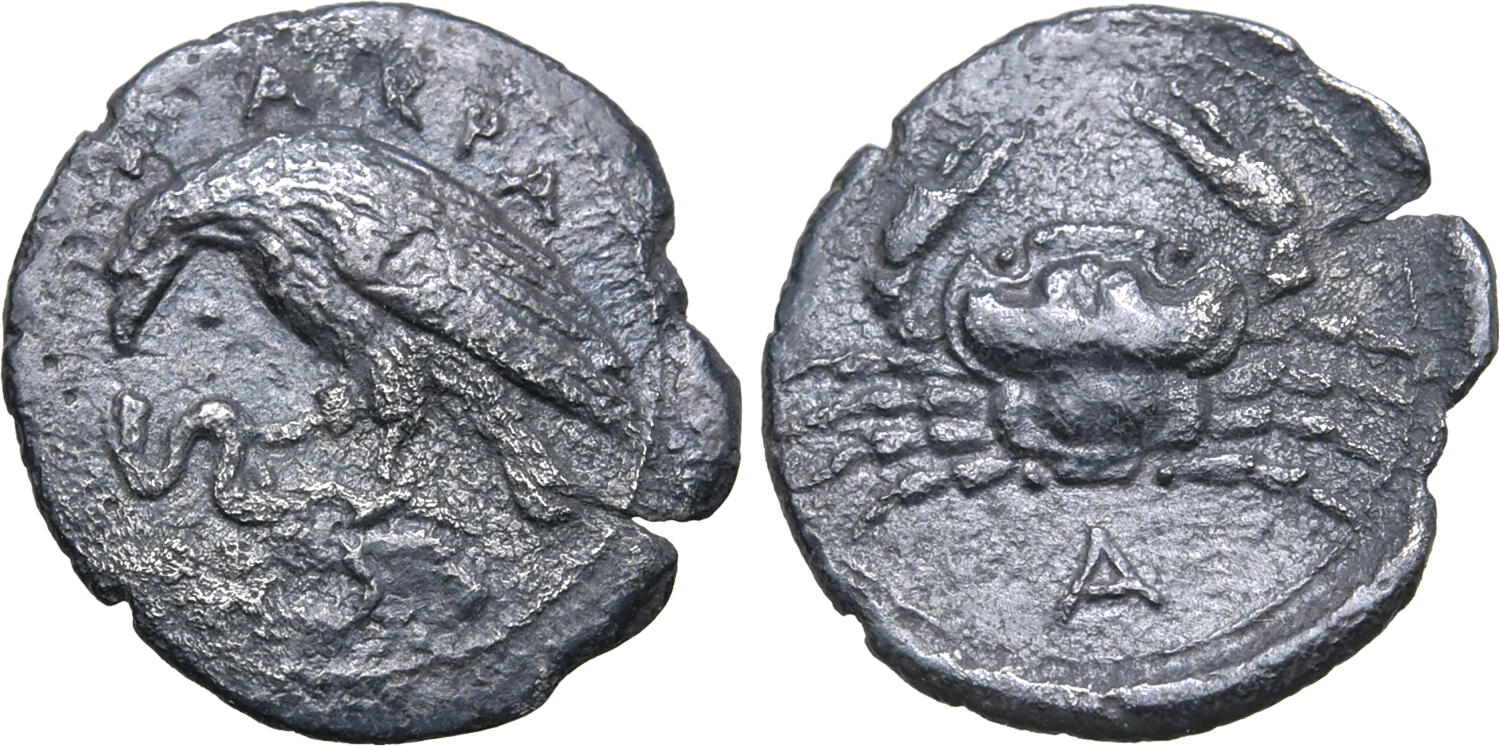S 1505 - Agrigentum, silver, litrai (410-406 BCE)
From SILVER
410 BCE - 406 BCE Silver 61 kg
Description
| ObverseInscription or printing placed on the obverse.: | AKPA above (Greek).Eagle standing to left on rock outcrop, tearing at serpent held in talons |
| ReverseInscription or printing placed on the reverse.: | Crab, A below |
Mint and issuing power
| MintIdentifies the place of manufacture or issue of a numismatic object.: | Agrigentum | Ancient regionAncient region.: | Sicily | Modern countryModern country: Italy | AuthorityIdentifies the issuing power. The authority can be "pretended" when the name or the portrait of X is on the coin but he/she was not the issuing power. It can also be "uncertain" when there is no mention of X on the coin but he/she was the issuing power according to the historical sources: |
Chronology
| FromIdentifies the initial date in a range assigned in a numismatic context. | 410 BCE | toIdentifies the final date in a range assigned in a numismatic context.. | 406 BCE | PeriodTime period of the numismatic object.: Classical 480-323 BC |
Physical description
| MetalThe physical material (usually metal) from which an object is made.: | Silver |
Median weightMedian of the weights of numismatic objects (in grams). in grams | 0.75 | DenominationTerm indicating the value of a numismatic object. Examples: tetradrachm, chalkous, denarius.: | litra |
StandardStandard.: | Attic |
Image

S 1505 - Agrigentum, silver, litrai (410-406 BCE).jpg [1]
References
| Die study referencePublication of the study: | Westermark 20181Westermark 2018, p. 203-204, n° 605-609 | ||
| Coin series referenceReference to coin series study: | HGC 22HGC 2, n° 114 | ||
| Coin series web referenceCoin series web references: | |||
Obverse dies distribution
| FrequencyFrequency of specimen in distribution. ᵖ | Number of obversesNumber of obverse dies. ᵖ (o) | % (o) | Number of coinsNumber of coins. (n) | % (n) | Die nameName(s) of the die(s). |
| 3 | 1 | 25 | 3 | 7.89 | 2 |
| 7 | 1 | 25 | 7 | 18.42 | 4 |
| 13 | 1 | 25 | 13 | 34.21 | 3 |
| 15 | 1 | 25 | 15 | 39.47 | 1 |
| Total | 4 of 4 | 100 | 38 of 38 | 99.99 |
Reverse dies distribution
no distribution is available
Quantification
| Number of obversesNumber of obverse dies. ᵖ (o) | 4 | Number of singletons (o1)The number of singleton coins. ᵖ | |
| Number of reverse diesNumber of reverse dies. (r) | 3 | Number of coinsNumber of coins. (n) | 38 |
| Coins per obverse dieNumber of coins per obverse die. (n/o) | 9.5 | Coins per reverse dieNumber of coins per reverse die. (n/r) | 12.67 |
| Reverse per obverse ratioRatio of obverse dies divided by reverse dies. (r/o) | 0.75 | Percentage of singletons (o1)number of coins (n) divided by the number of singletons (o1) ᵖ | % |
| Original number of dies (O) (Carter 1983 formula)The estimation of the number of coins according to Carter 1983 ᵖ | 4.08 | Coins struck if 20,000 as average productivity per dieCoins made if the average productivity for obverses (according to Carter) is 20,000. ᵖ | 81,600 |
| Original number of dies (O) (Esty 2011 formula)The estimation of the number of coins according to the singleton formula in Esty 2011 ᵖ (O) | 4.47 | Survival rate if 20,000 as average productivity per dieSurvival rate if average productivity is 20,000. ᵖ | 0.00047 |
| Coverage (o = % of O) (Esty 1984 formula)Esty 1984 - coverage (% of O) ᵖ (o = % of O) | % | Die productivity if survival rate 1/2,000Average productivity if survival rate is 1/2,000. ᵖ | 18,627.45 |
| Weight of silver (in kg) if 20,000 coins per die (O = Carter formula)Carter 1983 * Median weight * 20000 (*10 if gold or electrum) ᵖ | 61 kg <br /> 61 kg | Die productivity if survival rate 1/5,000Average productivity if survival rate is 1/5,000. ᵖ | 46,568.63 |
Remarks
References
- ^ Westermark, Ulla (2018), The coinage of Akragas c. 510-406 BC, 2 vol., Uppsala.
- ^ Hoover, Oliver D. (2012), The Handbook of Greek Coinage Series. 2. Handbook of the Coins of Sicily (Including Lipara). Civic, Royal, Siculo-Punic, and Romano-Sicilian Issues. Sixth to First Centuries BC, Lancaster-London, 489 p.